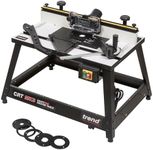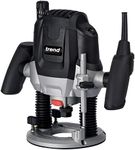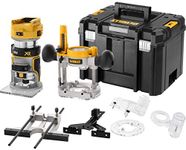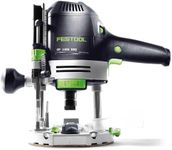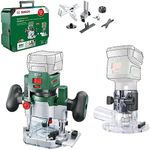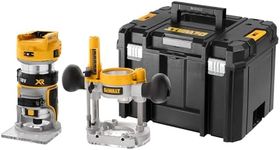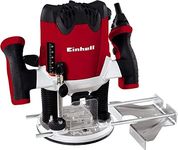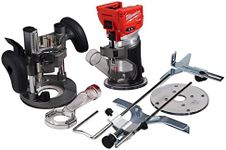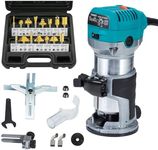Buying Guide for the Best Wood Routers
Choosing the right wood router can make a significant difference in the quality and efficiency of your woodworking projects. A wood router is a versatile tool used for hollowing out an area in the face of a piece of wood, and it can be used for a variety of tasks such as edging, cutting grooves, and creating intricate designs. To find the best wood router for your needs, it's important to understand the key specifications and how they relate to your specific projects and skill level.PowerPower in wood routers is measured in horsepower (HP) or amps. This spec is important because it determines how well the router can handle different types of wood and the complexity of the tasks. Routers with lower power (1-1.5 HP or 6-9 amps) are suitable for light-duty tasks and softwoods. Medium power routers (1.5-2.5 HP or 10-13 amps) are versatile and can handle a wider range of tasks and wood types. High power routers (2.5+ HP or 14+ amps) are best for heavy-duty tasks and hardwoods. Choose a power level based on the types of projects you plan to undertake and the materials you will be working with.
SpeedThe speed of a wood router is measured in revolutions per minute (RPM). This spec is important because different materials and tasks require different speeds for optimal results. Routers with a single speed are simpler but less versatile. Variable speed routers allow you to adjust the RPM to match the material and task, providing better control and finish. Lower speeds (8,000-15,000 RPM) are suitable for larger bits and harder materials, while higher speeds (15,000-25,000 RPM) are better for smaller bits and softer materials. Consider a variable speed router if you work with a variety of materials and bit sizes.
Collet SizeThe collet size determines the diameter of the router bits that the tool can accept. Common sizes are 1/4 inch and 1/2 inch. This spec is important because it affects the range of bits you can use and the stability of the router during operation. 1/4 inch collets are suitable for light-duty tasks and smaller bits, while 1/2 inch collets provide better stability and are suitable for heavier-duty tasks and larger bits. Some routers come with both collet sizes, offering greater versatility. Choose a collet size based on the types of bits you plan to use and the nature of your projects.
Base TypeWood routers come with different base types, including fixed base, plunge base, and combo kits. This spec is important because it affects the router's functionality and ease of use. Fixed base routers are stable and easy to control, making them ideal for edge work and simple tasks. Plunge base routers allow you to start cutting in the middle of a workpiece and are suitable for more complex tasks like inlays and mortises. Combo kits offer both base types, providing versatility for a range of tasks. Choose a base type based on the complexity of your projects and your comfort level with the tool.
ErgonomicsErgonomics refers to how comfortable and easy the router is to handle. This spec is important because it affects your control over the tool and reduces fatigue during extended use. Look for routers with comfortable grips, well-placed controls, and a balanced weight. Some routers also have features like soft-start motors and reduced vibration, which enhance comfort and control. Choose a router that feels comfortable in your hands and is easy to maneuver, especially if you plan to use it for long periods.
Dust CollectionDust collection refers to the router's ability to manage and collect the dust generated during operation. This spec is important because it helps keep your workspace clean and improves visibility while working. Some routers come with built-in dust collection systems or ports that can be connected to a vacuum. Effective dust collection not only keeps your work area cleaner but also protects your health by reducing airborne dust. Choose a router with good dust collection features if you work in a small or enclosed space or if you prioritize a clean working environment.

